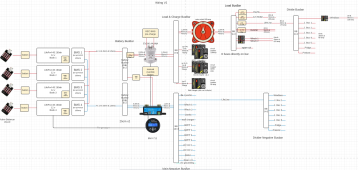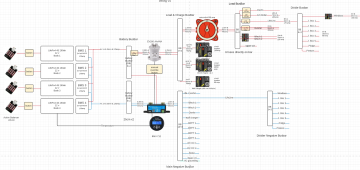ericjanvanputten
New Member
- Joined
- Oct 11, 2021
- Messages
- 16
Hi everyone,
My first topic starter here and it's a Diagram Check request, so shoot at it/me

The wiring diagram can be seen, and zoomed into, here: https://lucid.app/lucidchart/293e52...onId=inv_6c856dcc-2da2-4f01-a8cd-446b4f2c2ddb
The project:
Renew & modernize the main electricity and batteries on our french 1992 boat...
The goal is to be able to live on it at some moment in the future, and it's the wife and I.
The question:
Do I overlook something major here that will pose a risk to comfort, or health.
I do try to do this pretty close to as best ISO (so boathowto was awesome) as possible.
Main components and ideas behind them:
What is not in here (that i'm aware off):
what am I overlooking?
thank you!
edits:
26-11-2021: incorporated several feedback points from this forum into the image.
My first topic starter here and it's a Diagram Check request, so shoot at it/me

The wiring diagram can be seen, and zoomed into, here: https://lucid.app/lucidchart/293e52...onId=inv_6c856dcc-2da2-4f01-a8cd-446b4f2c2ddb
The project:
Renew & modernize the main electricity and batteries on our french 1992 boat...
The goal is to be able to live on it at some moment in the future, and it's the wife and I.
The question:
Do I overlook something major here that will pose a risk to comfort, or health.
I do try to do this pretty close to as best ISO (so boathowto was awesome) as possible.
Main components and ideas behind them:
- 4x EVE 280AH Lifepo4 12 volt banks (4 cells each)
- 4x BMS JBD-SP04S020 at 120amps each for combined max of 480amps
- Active balancers, not really needed but they can serve a purpose, and I will put an on/off button on these
- cables will be double isolated 70 degrees celsius, NON-tinned, but crimped everywhere
- double class t 225amp to protect the wires (also double)
- Contactor (big ass relay EV200) as last resort that can be killed by the BMV-712
This contactor can handle 500amps cont. - Contactor also has a manual button on it so I can kill it manually
- the chargers will be connected to this
- MPPT 1 to start, optional to 4 MPPTs
- a DC to DC to the engine(s)
- initially also the wall charger (Mastervolt 12/70-3 that support lithium)
This will later become part of the inverter if we switch to a victron multiplus 12/3000
- to the Load busbar I have put a main power switch
- On the busbar several fuses, incl 2x class T 225amp's to the inverter (first a 2kva, later the multiplus 12/3000, so its prepped for that)
- The life line, the backbone that basically goes to where the current center of electra is. This one is fused at 175amp. This so I dont have to fuse every cable to the J boxes (Junction boxes) from where it goes into small fuses to all the devices.
- and several other things
What is not in here (that i'm aware off):
- that balance sheet on how much power & generation I might need.
- the 220v AC
- the solar panels that will be added
- bilgepumps go via the junction boxes, and yes I know that you can consider them directly on the main batteries, but I'm fine with having this behind a J. box.
what am I overlooking?
thank you!
edits:
26-11-2021: incorporated several feedback points from this forum into the image.
Attachments
Last edited:




